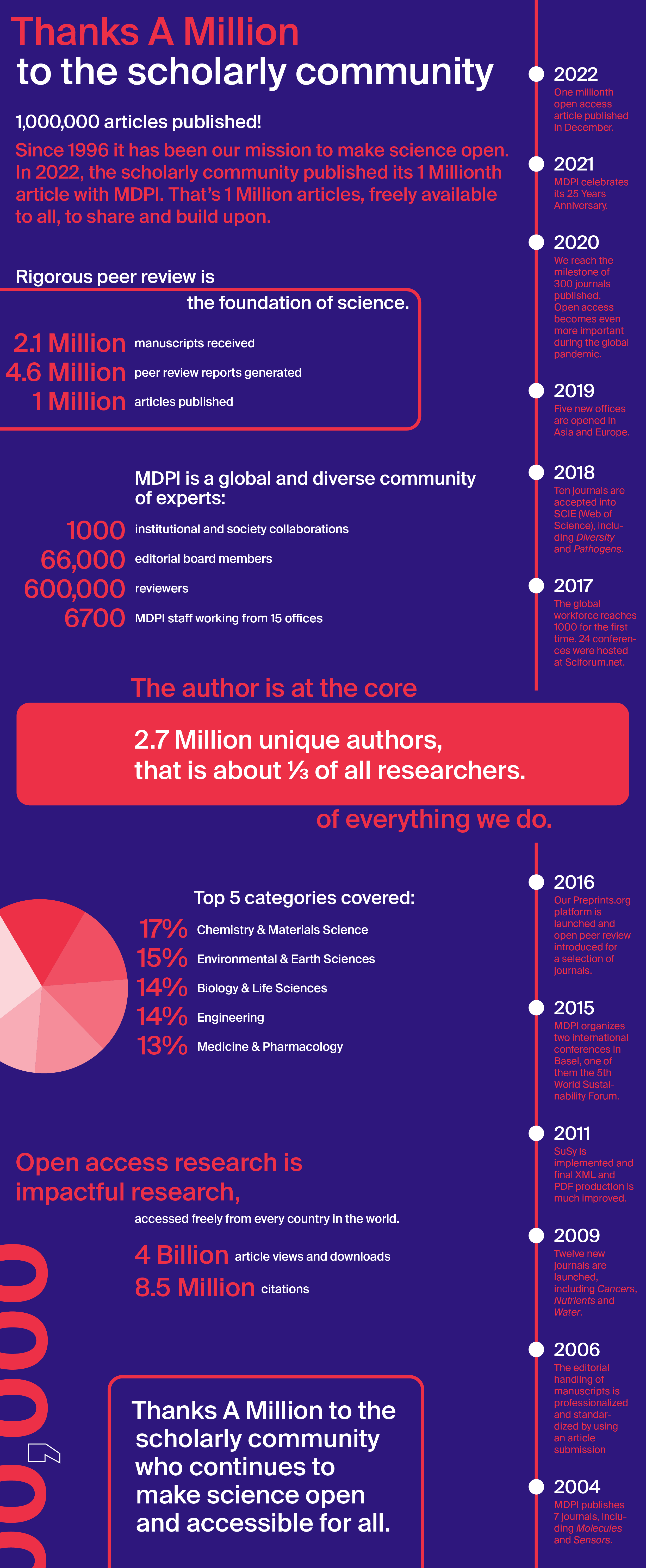
Journal Menu
► ▼ Journal Menu-
- Sensors Home
- Aims & Scope
- Editorial Board
- Reviewer Board
- Topical Advisory Panel
- Instructions for Authors
- Special Issues
- Topics
- Sections & Collections
- Article Processing Charge
- Indexing & Archiving
- Editor’s Choice Articles
- Most Cited & Viewed
- Journal Statistics
- Journal History
- Journal Awards
- Society Collaborations
- Conferences
- Editorial Office
Journal Browser
► ▼ Journal Browser-
arrow_forward_ios
Forthcoming issue
arrow_forward_ios Current issue - Vol. 25 (2025)
- Vol. 24 (2024)
- Vol. 23 (2023)
- Vol. 22 (2022)
- Vol. 21 (2021)
- Vol. 20 (2020)
- Vol. 19 (2019)
- Vol. 18 (2018)
- Vol. 17 (2017)
- Vol. 16 (2016)
- Vol. 15 (2015)
- Vol. 14 (2014)
- Vol. 13 (2013)
- Vol. 12 (2012)
- Vol. 11 (2011)
- Vol. 10 (2010)
- Vol. 9 (2009)
- Vol. 8 (2008)
- Vol. 7 (2007)
- Vol. 6 (2006)
- Vol. 5 (2005)
- Vol. 4 (2004)
- Vol. 3 (2003)
- Vol. 2 (2002)
- Vol. 1 (2001)
Need Help?
Announcements
26 December 2022
Sensors | Season’s Greetings from the Section Editor-in-Chief and Section Associate Editor of “Communications”

Prof. Dr. Xianbin Wang
Editor-in-Chief of the “Communications” Section

Prof. Dr. Peter Han Joo Chong
Section Associate Editor of the “Communications” Section
This Season’s Greetings video is from the Section Editor-in-Chief of the “Communications” Section, Prof. Dr. Xianbin Wang, who is the professor at Western University, and the Section Associate Editor Prof. Dr. Peter Han Joo Chong, who is from the Auckland University of Technology. The “Communications” Section of Sensors (ISSN: 1424-8220) was established in 2020 and publishes original peer-reviewed papers covering all aspects of the communications field, including, but not limited to, the design, implementation, and theoretical analysis of wireless communication, optical communication, and satellite communication systems; signal processing techniques; networking, data analytics; system operation; and emerging communication technologies.
26 December 2022
Sensors | Season’s Greetings from Prof. Dr. Yuh-Shyan Chen—Section Associate Editor of the “Sensor Networks” Section

This Season’s Greetings video is from the Section Associate Editor of the “Sensor Networks” Section in Sensors (ISSN: 1424-8220), Prof. Dr. Yuh-Shyan Chen, who is from National Taipei University.
The “Sensor Networks” Section was established in 2011. This Section covers topics, original research, and peer-reviewed articles related to the latest research and development in the field of sensor networks. It is an interdisciplinary domain that consists of wireless and wired communications, algorithms, and protocols, as well as energy sources to supply these networks. The section covers theoretical and experimental problems, especially considering the rise of the Internet of Things (IoT) applications that allow several devices to connect intelligently.
23 December 2022
Sensors | Season's Greetings from Prof. Dr. Chris Rizos—Section Editor-in-Chief of “Navigation and Positioning”

This Season's Greetings video is from the Section Editor-in-Chief of the "Navigation and Positioning" Section, Prof. Dr. Chris Rizos, who is a professor at the University of New South Wales.
The "Navigation and Positioning" Section of Sensors (ISSN: 1424-8220) was established in 2021 and publishes peer-reviewed papers covering all aspects of navigation and positioning.
Potential Topics in this Section include:
- Global navigation satellite systems (GNSS);
- Satellite-based augmentation systems (SBAS);
- Indoor localization systems (ILS);
- Geographic information systems (GIS);
- Industrial metrology and geodetic systems;
- Location-based services (LBS) and applications;
- Simultaneous localization and mapping (SLAM);
- Ultrasound positioning;
- Ultra-Wide-Band (UWB) positioning;
- Precise positioning;
- Navigation guidance;
- Inertial navigation;
- Indoor positioning, navigation, tracking methods;
- AoA-, TOF-, and TDOA-based localization;
- Signal Strength-Based Methods;
- Fingerprinting;
- Seamless positioning systems;
- Optical Positioning Systems;
- Indoor maps and 3D building models;
- Vehicle and personal location;
- Intelligent transportation;
- Path planning;
- Object tracking;
- Wireless positioning technologies;
- Navigation and visual scanning technologies;
- Applications of location awareness and context detection;
- Visual odometry;
- Pedestrian dead reckoning (PDR);
- Standards and interoperability;
- Human motion monitoring and modeling.
23 December 2022
Sensors | Season's Greetings from Dr. Felipe Jiménez—Section Board Member of “Vehicular Sensing”

This Season's Greetings video is from the Editorial Board Member Dr. Felipe Jiménez, from Universidad Politécnica de Madrid.
The "Vehicular Sensing" Section of Sensors (ISSN: 1424-8220) was established in 2021 and publishes original peer-reviewed papers and surveys covering all aspects of sensing technologies in relation to vehicles. "Vehicular Sensing" publishes studies on the collection of data by on-board sensors and their subsequent dissemination to other vehicles through vehicle-to-everything (V2X) communication. Thus, numerous applications and technologies have been, and continue to be, developed, including vehicle sensor networks (VSNs), vehicular transportation, unmanned underwater vehicles (UUVs), intelligent vehicles, vehicular communications, and traffic monitoring, etc.
23 December 2022
Sensors | Season’s Greetings from the Editor-in-Chief - Prof. Dr. Vittorio Passaro

This Season's Greetings video is from the Editor-in-Chief of Sensors, Prof. Dr. Vittorio Passaro, who is a professor of Politecnico di Bari. I send my best wishes of a happy new year to all our readers and contributors. I am sure that our journal will have a further success next year.
He is also leading the “Optical Sensors” section. This section was established in 2019 and it addresses all aspects of optical sensing, including source and detection technologies, sensing architectures, physical effects for sensing, sensor performance, sensor technology, readout techniques, lab-on-a-chip optical devices, processing approaches and applications, as well as actuation and control by light. These optical sensors and actuators include micro- and nano-optical devices, large devices, sensor arrays, integrated optical sensors, fiber-optic sensors, as well as several materials and technologies for a very large number of applications, including civil infrastructure, aerospace, biomedical, environmental monitoring, etc.
22 December 2022
Special Issue Mentor Program
We are pleased to announce the launch of a new initiative—the MDPI Special Issue Mentor Program.
This program will enable early career researchers (who must hold a Ph.D. in a related field) to experience editing a Special Issue in MDPI journals, under the mentorship of our experienced Editorial Board Members or other experienced scientists. The mentor program will provide an excellent opportunity for early career scientists to gain editorial experience, and to cultivate their ability to edit scientific research.
The mentee’s responsibilities include:
- Proposing a Special Issue title and assisting the mentor in preparing a summary (around 200–400 words) and 3–10 keywords describing the background, importance, and goal of the Issue;
- Writing a brief promotion plan for the Special Issue;
- Preparing a list of scholars who may be interested in the Issue and personally e-mailing invitations on behalf of Guest Editors;
- Writing an editorial for the online Special Issue together with the mentor.
The mentor’s responsibilities include:
- Conducting a final check before the Special Issue is published online;
- Performing editorial control of the Special Issue and quality control of the publications, both of which must be carried out in a timely manner;
- Providing suggestions to younger scholars if they have any doubts or concerns regarding submissions;
- Organizing video calls with young scholars and the Editorial Office regularly to discuss problems and improvement suggestions for the Special Issue;
- Making and submitting decisions regarding submissions with the assistance of mentees.
Certificates and awards:
After the Special Issue closes, the Editorial Office will provide official certificates for all the mentors and early career researchers.
If you are interested in this opportunity, please send your Special Issue proposal to the Editorial Office of a journal you choose, and we will discuss the process (i.e., mentor collaboration, Special Issue topic feasibility analysis, etc.) in further detail. The full list of MDPI journals is as follows: https://www.mdpi.com/about/journals.
In addition to the new Special Issue Mentor Program, we will continue to welcome all Special Issue proposals focusing on hot research topics.
14 December 2022
"Thanks a Million!" – One Million Articles Published in MDPI Journals
MDPI has just become the first open access (OA) publisher to reach the milestone of one million articles published. That is one million articles freely available to all, to circulate and build upon! We are proud to share this special moment with the global scientific community.
This landmark has been reached thanks to the immeasurable support of more than 600,000 expert reviewers, 66,000 editorial board members and 6700 hard-working colleagues across MDPI’s global offices.
Within more than 25 years of publishing, our journals received 2.1 million manuscripts and generated 4.6 million peer review reports to get to one million papers published.
Reaching the milestone of one million articles published reinforces our mission to remove any existing barriers and to make scientific research accessible to all. Since its inception, MDPI’s goal has been to create reliable processes to make science open. This is a path towards facilitating the dissemination of novel insights in scientific communities.
Regular feedback from authors and reviewers shows that our service is greatly appreciated and needed. At the same time, the feedback helps us identify areas for further improvement.
As it stands, a significant share of published research findings remain closed access. More than half of the content published with the most well-known legacy publishers stays behind a paywall, and that is not including articles published in hybrid OA journals, or made available months or years after publication.
A new policy announced by the US administration in August 2022 requires that, as of January 2026, all US federally funded research be made freely and immediately available after publication. While the new policy does not mandate articles be published under an open access license, it is aligned with the open access movement in removing all barriers to research. Similarly, some of the most advanced research institutions in the world intend to have all funded research articles published in open access by 2025.
MDPI is proud to be the leading agent of the transition to open access.
"Thanks a Million" to all the contributors!
8 December 2022
MDPI Sustainability Foundation: New Look and Nominations for the 2023 Sustainability Awards Now Open

We are pleased to announce that the website of the MDPI Sustainability Foundation has been revamped! For the past couple of months, our UX UI team and front-end developers have been working hard to launch the website in time for the opening of the Sustainability Awards nominations.
The website is not the only thing that has had a remodeling. Indeed, the format of the Emerging Sustainability Leader Award (ESLA) has been updated. ESLA is now a competition open to individual researchers or start-ups founded by researchers under the age of 35. Nominee applications will go through 2 rounds of selection until the final 3 are decided. The finalists will then be invited to give pitch presentations during the Award Ceremony to win either first place (10,000 USD) or runner-up (2 x 5000 USD).
The World Sustainability Award, on the other hand, remains the same: a total prize money of 100,000 USD is up for grabs by senior individual researchers or groups of researchers from the international research community.
Nominations for both the World Sustainability Award and the Emerging Sustainability Leader award are now open! Check out our new website for more information on how to nominate.
28 November 2022
Dr. Mikhael Bechelany Appointed Section Editor-in-Chief of the Section “Sensor Materials” in Sensors
We are pleased to announce that Dr. Mikhael Bechelany has been appointed Section Editor-in-Chief of the “Sensor Materials” Section in Sensors (ISSN: 1424-8220).

Name: Dr. Mikhael Bechelany
Email: mikhael.bechelany@umontpellier.fr
Affiliation: European Institute of Membranes (IEM), University of Montpellier, 34090 Montpellier, France
Homepage: http://www.iemm.univ-montp2.fr/spip.php?article140&lang=en&lang=fr
Research Keywords: atomic layer deposition; photocatalysis; electrospinning; nanomaterials; sensors; thin films
Dr. Mikhael Bechelany is a CNRS Research Director at the European Institute of Membranes (IEM), University of Montpellier. His current research interests include novel synthesis methods for metals and ceramics nanomaterials such as Atomic Layer Deposition (ALD), electrodeposition, electrospinning, 3D printing and/or nanostructuring using natural lithography (nanospheres and/or membranes). His research efforts include the design of nanostructured membranes for health, the environment and renewable energy. He is the author and co-author of more than 300 publications, 15 book chapters and 12 patents (h-index = 57).
The following is a short Q&A with Dr. Mikhael Bechelany, who shared his vision for the journal with us, as well as his views of the research area and Open Access publishing:
1. What appealed to you about the journal that made you want to take the role as Section Editor-in-Chief?
Sensors is a leading journal in the field. The journal is very highly ranked, with a great impact factor and large visibility. The journal also benefits from the high-quality service of MDPI, a pioneer in scholarly, open access publishing. As a result, I was honored to be invited to be the Editor-in-Chief.
2. What is your vision for the Section?
The “Sensor Materials” Section is becoming highly important, tackling the key role of materials in transduction. Our Section will underscore high-impact research and manuscripts in innovative sensor applications and technology from around the world, appealing to scientists, researchers and professionals interested in designing innovative materials for sensor applications.
3. What does the future of this field of research look like?
The main key trend in the sensors field is miniaturization. In order to tackle this issue, materials design is playing a central role in sensor systems. The growing fundamental and applied research in this area will allow our Section to publish high-quality and interdisciplinary research in different classes of materials for use in sensor applications such as semiconducting materials, ceramic materials, metallic materials, organic materials, piezoelectric materials, two-dimensional materials, nanomaterials, biomaterials and biological-derived materials, metal organic frameworks, soft materials, metamaterials and chromogenic materials.
4. What do you think of the development of Open Access in the publishing field?
The development of Open Access in the publishing field has been very important for the scientific community, as it allows research findings to be shared as rapidly, openly and effectively as possible. Open Access will allow the excellent works published by our Section to be freely available to researchers all over the world. This will increase the potential for more people to see and download our Section publications, accelerating and amplifying the impact of the published works.
We wish Dr. Mikhael Bechelany every success in his new position, and we look forward to his contributions to the journal.
28 November 2022
Sensors | Top 10 Cited Papers in 2020 in the Section “Wearables”
1. “In-Ear SpO2: A Tool for Wearable, Unobtrusive Monitoring of Core Blood Oxygen Saturation”
by Harry J. Davies, Ian Williams, Nicholas S. Peters and Danilo P. Mandic
Sensors 2020, 20(17), 4879; https://doi.org/10.3390/s20174879
Available online: https://www.mdpi.com/1424-8220/20/17/4879
2. “Iterative Learning Control for a Soft Exoskeleton with Hip and Knee Joint Assistance”
by Chunjie Chen, Yu Zhang, Yanjie Li, Zhuo Wang, Yida Liu, Wujing Cao and Xinyu Wu
Sensors 2020, 20(15), 4333; https://doi.org/10.3390/s20154333
Available online: https://www.mdpi.com/1424-8220/20/15/4333
3. “The Potential Role of Sensors, Wearables and Telehealth in the Remote Management of Diabetes-Related Foot Disease”
by Jonathan Golledge, Malindu Fernando, Peter Lazzarini, Bijan Najafi and David G. Armstrong
Sensors 2020, 20(16), 4527; https://doi.org/10.3390/s20164527
Available online: https://www.mdpi.com/1424-8220/20/16/4527
4. “Feasibility of a Wearable Reflectometric System for Sensing Skin Hydration”
by Raissa Schiavoni, Giuseppina Monti, Emanuele Piuzzi, Luciano Tarricone, Annarita Tedesco, Egidio De Benedetto and Andrea Cataldo
Sensors 2020, 20(10), 2833; https://doi.org/10.3390/s20102833
Available online: https://www.mdpi.com/1424-8220/20/10/2833
5. “Wearable Flexible Strain Sensor Based on Three-Dimensional Wavy Laser-Induced Graphene and Silicone Rubber”
by Lixiong Huang, Han Wang, Peixuan Wu, Weimin Huang, Wei Gao, .Feiyu Fang, Nian Cai, Rouxi Chen and Ziming Zhu
Sensors 2020, 20(15), 4266; https://doi.org/10.3390/s20154266
Available online: https://www.mdpi.com/1424-8220/20/15/4266
6. “Wearable Inertial Sensors for Gait Analysis in Adults with Osteoarthritis—A Scoping Review”
by Dylan Kobsar, Zaryan Masood, Heba Khan, Noha Khalil, Marium Yossri Kiwan, Sarah Ridd and Matthew Tobis
Sensors 2020, 20(24), 7143; https://doi.org/10.3390/s20247143
Available online: https://www.mdpi.com/1424-8220/20/24/7143
7. “Foot Pressure Wearable Sensors for Freezing of Gait Detection in Parkinson’s Disease”
by Andrea Marcante, Roberto Di Marco, Giovanni Gentile, Clelia Pellicano, Francesca Assogna, Francesco Ernesto Pontieri, Gianfranco Spalletta, Lucia Macchiusi, Dimitris Gatsios, Alexandros Giannakis et al.
Sensors 2021, 21(1), 128; https://doi.org/10.3390/s21010128
Available online: https://www.mdpi.com/1424-8220/21/1/128
8. “Compact and Low-Profile UWB Antenna Based on Graphene-Assembled Films for Wearable Applications”
by Ran Fang, Rongguo Song, Xin Zhao, Zhe Wang, Wei Qian and Daping He
Sensors 2020, 20(9), 2552; https://doi.org/10.3390/s20092552
Available online: https://www.mdpi.com/1424-8220/20/9/2552
9. “Toward Using Wearables to Remotely Monitor Cognitive Frailty in Community-Living Older Adults: An Observational Study”
by Javad Razjouyan, Bijan Najafi, Molly Horstman, Amir Sharafkhaneh, Mona Amirmazaheri, He Zhou, Mark E. Kunik and Aanand Naik
Sensors 2020, 20(8), 2218; https://doi.org/10.3390/s20082218
Available online: https://www.mdpi.com/1424-8220/20/8/2218
10. “Wearable Design Requirements Identification and Evaluation”
by Leire Francés-Morcillo, Paz Morer-Camo, María Isabel Rodríguez-Ferradas and Aitor Cazón-Martín
Sensors 2020, 20(9), 2599; https://doi.org/10.3390/s20092599
Available online: https://www.mdpi.com/1424-8220/20/9/2599




